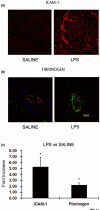Fibrinogen decreases cardiomyocyte contractility through an ICAM-1-dependent mechanism
- PMID: 18173852
- PMCID: PMC2374637
- DOI: 10.1186/cc6213
Fibrinogen decreases cardiomyocyte contractility through an ICAM-1-dependent mechanism
Abstract
Introduction: Cardiomyocytes exposed to inflammatory processes express intracellular adhesion molecule-1 (ICAM-1). We investigated whether fibrinogen and fibrinogen degradation products, including D-dimer, could alter cardiomyocyte contractile function through interaction with ICAM-1 found on inflamed cardiomyocytes.
Methods: In vivo, rats were injected with endotoxin to model systemic inflammation, whereas isolated rat cardiomyocytes were treated with tumor necrosis factor-alpha to model the inflammatory environment seen following exposure to bacterial products such as lipopolysaccharide.
Results: In vivo, endotoxin administration profoundly decreased cardiac contractile function associated with a large increase in intracardiac ICAM-1 and perivascular fibrinogen. Confocal microscopy with double-staining of isolated rat cardiomyocytes demonstrated colocalization of ICAM-1 and fibrinogen. This interaction was disrupted through pre-treatment of the cells with an ICAM-1-blocking antibody. Functionally, isolated rat cardiomyocyte preparations exhibited decreased fractional shortening when incubated with fibrinogen, and through the use of synthetic peptides, we determined that residues 117-133 of the fibrinogen gamma chain are responsible for this interaction with ICAM-1. Despite having crosslinked gamma chains, D-dimer retained the ability to decrease cardiomyocyte contractility.
Conclusion: Site 117-133 of the fibrinogen gamma chain is able to depress cardiomyocyte contractility through binding ICAM-1.
Figures








References
-
- Van Eyk JE, Powers F, Law W, Larue C, Hodges RS, Solaro RJ. Breakdown and release of myofilament proteins during ischemia and ischemia/reperfusion in rat hearts: identification of degradation products and effects on the pCa-force relation. Circ Res. 1998;82:261–271. - PubMed
-
- Reilly JM, Cunnion RE, Burch-Whitman C, Parker MM, Shelhamer JH, Parrillo JE. A circulating myocardial depressant substance is associated with cardiac dysfunction and peripheral hypoperfusion (lactic acidemia) in patients with septic shock. Chest. 1989;95:1072–1080. doi: 10.1378/chest.95.5.1072. - DOI - PubMed
-
- Yano M, Ono K, Ohkusa T, Suetsugu M, Kohno M, Hisaoka T, Kobayashi S, Hisamatsu Y, Yamamoto T, Noguchi N, et al. Altered stoichiometry of FKBP12.6 versus ryanodine receptor as a cause of abnormal Ca(2+) leak through ryanodine receptor in heart failure. Circulation. 2000;102:2131–2136. - PubMed
Publication types
MeSH terms
Substances
LinkOut - more resources
Full Text Sources
Other Literature Sources
Miscellaneous

